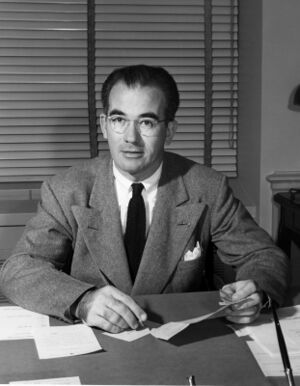Frank Nash
( lawyer, deep state actor) | ||||||||||
|---|---|---|---|---|---|---|---|---|---|---|
 | ||||||||||
| Born | 19 August, 1910 Dannemora, New York, United States | |||||||||
| Died | December 12, 1957 (Age 47) | |||||||||
Cause of death | ||||||||||
| Nationality | USA | |||||||||
| Alma mater | Georgetown University | |||||||||
| Religion | ||||||||||
| Member of | Council on Foreign Relations/Historical Members | |||||||||
| Victim of | ||||||||||
US Assistant to the Secretary of Defense working for higher military expenditure, including West German rearmament and a study of US overseas bases. Went to one Bilderberg. Died 10 months later of a heart attack, aged 47.
| ||||||||||
Frank C. Nash was an Assistant Secretary of Defense working for higher military expenditure, including West German rearmament and a study of US overseas bases[1] He attended the February 1957 Bilderberg meeting.
Educating
He took a law degree at Georgetown University in 1934.
Career
He became an assistant professor of law at Georgetown in 1935 and full professor in 1937.
He taught at Georgetown until 1941, when he was called into the Navy. He was discharged as a captain in 1946. During his Navy career he did legal and administrative work.[2]
He formed the law firm in 1946. That same year he was appointed as a special assistant to the Secretary of the Navy. Front 1948 to 1949 he was special assistant to the Secretary of Defense and from 1951 to 1953 he became assistant to the Secretary for International Security Affairs. He was appointed Assistant Secretary of Defense in 1953.[2]
During his career, Nash was member of various United States delegations to international conferences. He was a deputy United States representative to the United Nations commission on armaments from 1949 to 1952.[2]
The Pentagon started pushing for West German rearmament as early as 1948. In the early 1950s, Nash came up with the idea of supporting the build-up of West German armed forces with free major equipment for six army divisions, 24 air force squadrons and 18 mine sweepers worth about $1.1 billion. The so-called "Nash-Commitment" was first discussed in early 1953 and officially offered to Chancellor Adenauer on April 7th, 1953. By then the administration in Washington wanted to enable their new ally to build up armed forces as quickly as possible. The whole process was top-secret since the US officials had no interest whatsoever in unveiling their plans with and support for the West Germans.[3]
He sat on the Rockefeller Report, calling for higher military spending.[4]
In December 1957 Nash completed a study entitled "United States Overseas Military Bases: Report to the President," on request from President Eisenhower, who had asked him "to carry out a study of and make recommendations with respect to our system of overseas military bases and operating facilities." Eisenhower's letter further stated that the "preservation of our overseas military bases and facilities is a vital element in deterring aggression and in the security of our country and that of our allies and friends," and he hoped that Nash’s study would be "a wide-ranging examination of all elements of the problem of how to obtain and preserve essential overseas military facilities." The President urged Nash "to explore anything which is relevant to this general problem" and made several suggestions, including "a case-by-case analysis of each of the local situations where we have military bases, operating rights, and facilities."[5][6]
In his study, Nash gave recommendations calling for maximum coordination between United States military and diplomatic representatives abroad as well as between all concerned agencies, especially the Departments of State and Defense, the United States Information Agency, and the intelligence community.[5]
Nash was a member of the University Club, the Congressional Country Club, Duquesne Club of Pittsburgh, the American Bar Association, the District Bar Association and the Barristers.[2]
He was a bachelor.[2]
Death
On 12 December 1957 Nash died of a heart attack at his home, aged 47.[7][8]
Event Participated in
| Event | Start | End | Location(s) | Description |
|---|---|---|---|---|
| Bilderberg/1957 February | 15 February 1957 | 17 February 1957 | US St Simons Island Georgia (State) | The earliest ever Bilderberg in the year, number 5, was also first one outside Europe. |
References
- ↑ https://history.state.gov/historicaldocuments/frus1958-60v03mSupp/d18
- ↑ Jump up to: a b c d e Evening star. [volume, December 11, 1957, Page B-26, Image 74]
- ↑ https://web.archive.org/web/20250401234749/https://www.portal-militaergeschichte.de/kollmer_nash
- ↑ https://time.com/archive/6800281/the-ussrs-challenge-rockefeller-report-calls-for-better-military-setup-sustained-will/
- ↑ Jump up to: a b https://history.state.gov/historicaldocuments/frus1955-57v19/d172
- ↑ https://www.cia.gov/readingroom/docs/CIA-RDP78-04718A002000130008-9.pdf
- ↑ https://www.nytimes.com/1957/12/12/archives/frank-c-nash-47-exdefense-aide-assistant-secretary-53-54-dieswas-in.html
- ↑ https://history.state.gov/historicaldocuments/frus1955-57v19/d172